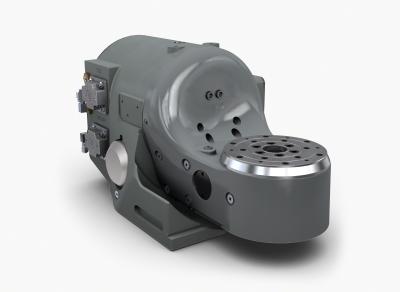
Five-axis machining is a powerful tool for reducing setup times and increasing accuracy on complex parts. But investing in a 5-axis machine tool may not be in the budget, especially for smaller shops. The all-new TRT160 tilting rotary table from Haas Automation not only puts 5-axis capabilities well within reach of the average job shop, but its new smaller size also provides greater mounting flexibility than its predecessor.
The company completely redesigned the TRT160 to create a much more compact and versatile 5-axis solution for smaller mills, including Haas Mini Mills and Toolroom Mills. The new unit easily fits on one end of a machine’s table, leaving the remainder open for additional fixtures or vises. The rotary’s 160 mm (6.3") platter – with three tapped bolt-hole patterns – swings parts up to 10.5" (267 mm) diameter, and has a maximum capacity of 150 lb (67 kg). The unit provides ±120 degrees of tilt and 360 degrees of rotation for full simultaneous 5-axis motion or to position parts to nearly any angle for machining.
Powerful brushless servomotors provide 210 ft-lb (285 Nm) of torque on the tilt axis, and 112 ft-lb (151 Nm) of torque on the rotary axis. Brake torque is 200 ft-lb (271 Nm) on the tilt axis, and 100 ft-lb (136 Nm) on the rotary axis. Indexing speeds are 104 deg/sec on both axes for quick cycle times.
Connecting the TRT160 to a Haas mill with 4th- and 5th-axis drives is fast and easy, with plug-and-play compatibility. And the necessary drives can be added in the field to all 3-axis Haas mills to gain 5-axis capability. Simply order the drives through our online Haas parts catalog at Parts.HaasCNC.com.
Whether you’re doing 3+2 positioning or full 5-axis machining, the all-new TRT160 tilting rotary table can reduce or totally eliminate multiple setups, and easily handle multiple-sided parts – even on small machining centers.
Contact Details
Related Glossary Terms
- centers
centers
Cone-shaped pins that support a workpiece by one or two ends during machining. The centers fit into holes drilled in the workpiece ends. Centers that turn with the workpiece are called “live” centers; those that do not are called “dead” centers.
- milling machine ( mill)
milling machine ( mill)
Runs endmills and arbor-mounted milling cutters. Features include a head with a spindle that drives the cutters; a column, knee and table that provide motion in the three Cartesian axes; and a base that supports the components and houses the cutting-fluid pump and reservoir. The work is mounted on the table and fed into the rotating cutter or endmill to accomplish the milling steps; vertical milling machines also feed endmills into the work by means of a spindle-mounted quill. Models range from small manual machines to big bed-type and duplex mills. All take one of three basic forms: vertical, horizontal or convertible horizontal/vertical. Vertical machines may be knee-type (the table is mounted on a knee that can be elevated) or bed-type (the table is securely supported and only moves horizontally). In general, horizontal machines are bigger and more powerful, while vertical machines are lighter but more versatile and easier to set up and operate.
